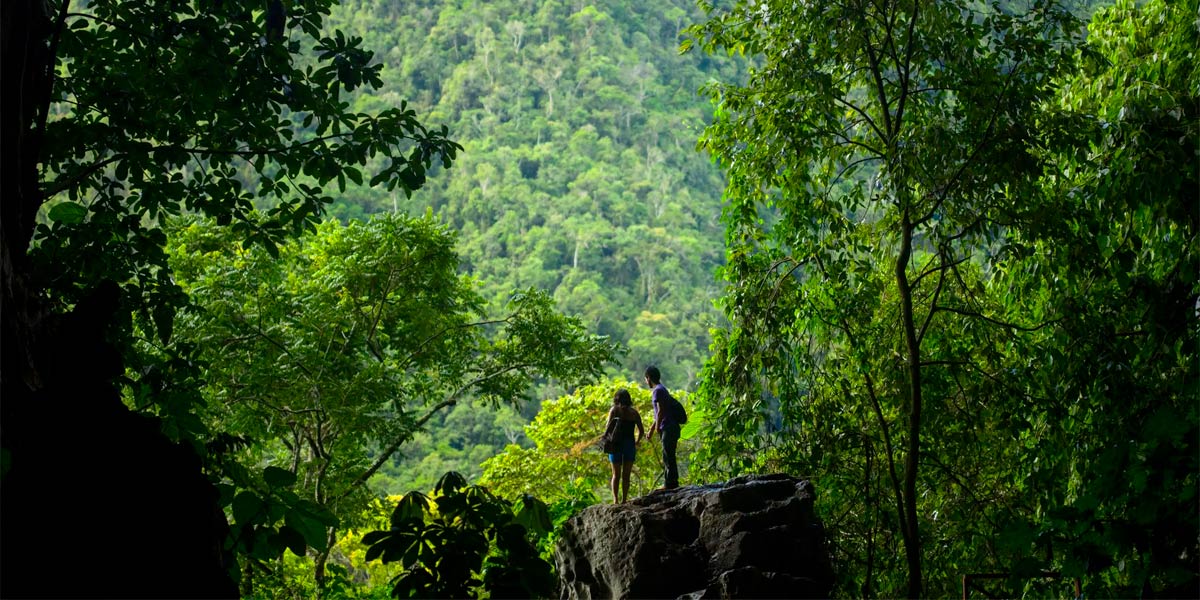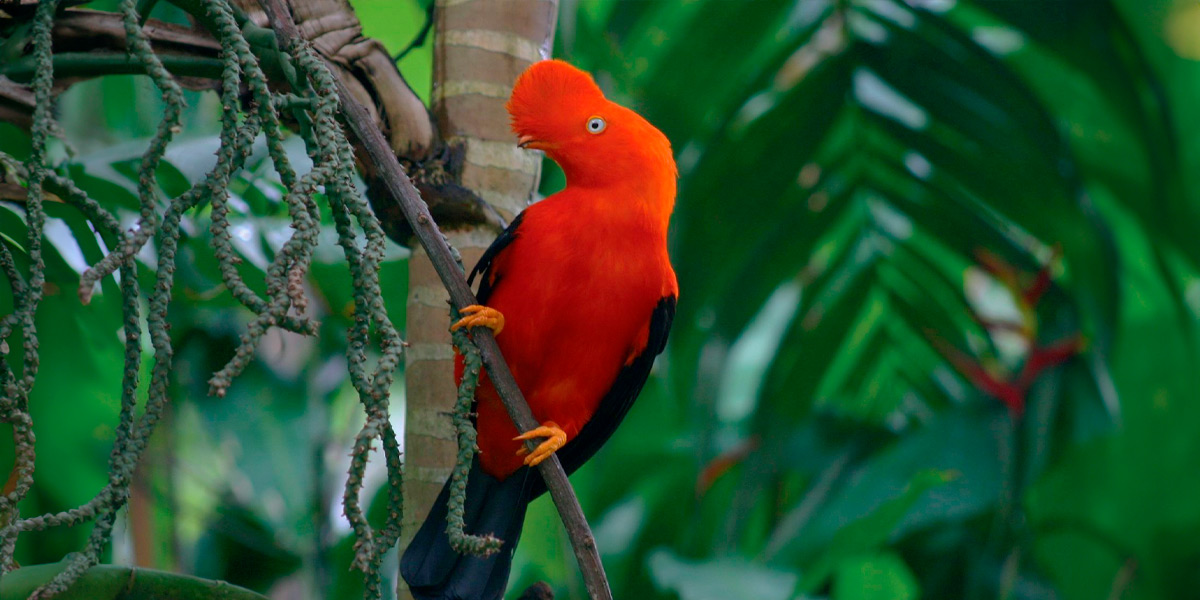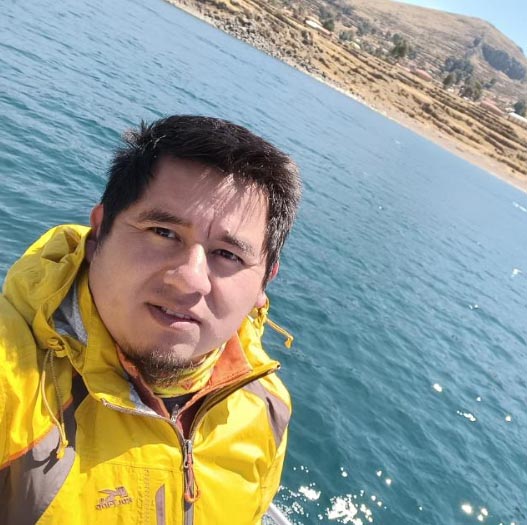The Tingo Maria National Park, located in the Huanuco region, is one of the most impressive natural places in Peru. With its amazing landscape ruled by the mountain shape known as “La Bella Durmiente”, this place offers a setting full of beauty, history, and conservation. Its importance is not only shown in the biodiversity it protects but also in the international awards it has received, such as its part in the Green Destinations Story Awards, where it stood out for its efforts in sustainability and responsible tourism.
The park is considered the second natural protected area of Peru, created in 1965 by Law N.° 15574. Its purpose was to protect the geographic and natural attractions like La Bella Durmiente and the mysterious Cueva de las Lechuzas (formerly called Cueva de los Búhos), in addition to protecting the great variety of flora and fauna that lives there. Among its most well-known species are birds, mammals, orchids, and a variety of medicinal plants of the high jungle.
In addition, this area has a vital role in the social and economic development of local communities, as it promotes tourism and sustainable activities that create direct benefits for the people. Today, visiting the Tingo Maria National Park means entering a unique natural place, perfect for hiking, exploring caves, and bird watching, while enjoying the contrast between the jungle, the mountains, and the Huallaga River.
Location and extent
The Tingo Maria National Park is located in the district of Mariano Dámaso Beraún, province of Leoncio Prado, in the department of Huanuco. It is part of the high jungle ecoregion, which gives it a warm and humid climate, ideal for the development of a great variety of flora and fauna species.
This protected natural area covers a surface of 4,777 hectares, within which are impressive landscapes such as the mountain range known as the Sleeping Beauty and unique geological formations like the Cave of the Owls. Its strategic location makes the park an important refuge for biodiversity and a tourist attraction to get to know part of the Peruvian Amazon.
Boundaries
The limits of the Tingo María National Park are determined as follows:
- To the north: right bank of the Monzón River, from the Cueva de las Owls tourist area to the meeting with the Huallaga River.
- To the east: With the Huallaga River on the right bank, heading upstream along the limits of the slopes and passing through the areas of Brisas del Huallaga, Afilador, Las Orquídeas, Puente Prado, La Perla, Cueva de las Pavas, Quezada and Tambillo Grande.
- To the south: left bank of the Tres de Mayo ravine from the vicinity of its mouth to the Huallaga River to the Gloriapata waterfall.
- To the west: It begins from the Gloriapata waterfall, following the Tres de Mayo ravine, reaching the Perdido River swallowhole, continuing upstream until the meeting of the Santa and Colorada ravines, crossing north until reaching the summit and following the Oro river. until its arrival at the Monzón River.
About Tingo Maria National Park
-
Biological Importance
Tingo Maria Park is home to an extraordinary biological diversity, typical of the high jungle, and plays a vital role as a water source for the region. Among its most famous landscapes are the mountain range that forms the silhouette of a reclining woman, known as “La Bella Durmiente” (The Sleeping Beauty), as well as the Cave of the Owls, home to the oilbirds and a very visited tourist attraction.Important Fact: The park protects ecosystems that are part of the Huallaga River watershed, ensuring the availability of water for thousands of people and acting as a natural climate regulator. -
Fauna and Flora
The park is a good place for bird watching, with about 364 species registered. Among them, the Andean cock of the rock, the national bird of Peru, stands out, along with toucans, parrots, woodpeckers, and the unique oilbirds of the Cave of the Owls.
As for mammals, impressive species like the puma, the jaguar or otorongo, the margay, the capybara, and the otter live here, in addition to peccaries and water opossums. Also notable are the 320 species of butterflies, including the impressive blue morphos, which shine with metallic tones when flying in the jungle.
The flora is equally diverse. In the high areas (up to 1800 masl), the vegetation is dense and covered with mosses, lichens, bromeliads, and orchids. As you go down, the forests rise with species of lauraceae, clusiaceae, and rubiaceae, in addition to tree ferns. On the lower slopes, large trees like the cumala, the moena, and the zapotillo are dominant.Curious Fact: In some areas of the park, endemic orchids have been found that do not exist anywhere else in the world, which makes it a point of interest for international botanists. -
Climate
The climate of Tingo Maria National Park is tropical and humid, with an average temperature of 24.5 °C. Annual rainfall ranges from 3,000 to 3,500 mm, and relative humidity stays at 80%. These conditions allow for the existence of lush vegetation throughout the year and favor the high biodiversity that characterizes the park.
Tourism sectors
The Tingo María National Park has three sectors:
Tourist sector Owl Cave:
It is the main tourist attraction of the Park, located 7 kilometers from the city of Tingo María, on the road to the town of Monzón. It is made up of the entrance avenue to the Cueva River bridge, with a Picnic area located in the Ojo de Agua sector 300 meters from the entrance access to the Cueva de las Owls.
Inside the cave we find stalactites, stalagmites, mantles and columns, formed over thousands of years, the cave houses an important colony of guacharos, bats, insects, porcupine, among others.
This sector has tourist orientation services, photo taking, hygienic services, sale of sandwiches, crafts, artisanal ice cream, typical local dishes and drinks.
Check-in time is from 08:00 a.m. to 5:30 p.m. and the activities that can be carried out are bird watching, flora and fauna in general; ecotourism, camping, recreational activities in the Cueva River spa where there is a picnic area.
Tourism sector Tres de Mayo
It is located south of the Park, 14 kilometers from the city of Tingo María, on the stretch of the highway to Huánuco, a trip of approximately 20 minutes by vehicle. This place is accessed through a suspension bridge over the Huallaga River located in the Tambillo Chico hamlet.
At the beginning of the tour you can see an orchid garden, butterfly garden, aviary, medicinal, forest and ornamental plants. You can also see beautiful waterfalls with three falls of crystalline waters such as Gloriapata at 1.8 kilometers, Sol Naciente at 4.76 kilometers and Salto del Ángel at 5.46 kilometers. In addition, there are tourist orientation services, accommodation, sale of sandwiches, typical local dishes and drinks.
Check-in time is from 08:00 a.m. to 3:00 p.m. and the permitted activities are bird watching and flora and fauna in general, community tourism, camping and recreational activities such as hiking and visiting the waterfalls.
Quinceañera tourism sector
Located 7 kilometers from the city of Tingo María, on the stretch of the highway to Huánuco, this attraction is accessed by crossing a huaro over the Huallaga River. Then you must walk approximately 1 kilometer to reach the Quinceañera waterfall. There you can enjoy a 43-meter waterfall, surrounded by lush vegetation typical of the premontane ecoregion. This destination has tourist orientation services, sale of snacks and drinks, and huaro transfer service.
Entry time is from 8:00 a.m. to 4:00 p.m. and the activities that can be carried out are bird watching and flora and fauna in general, hiking, bathing in the crystal clear waters of waterfalls and other recreational activities.
Worldwide recognition
Tingo María National Park was recognized as the only Peruvian destination among sustainable tourism stories in the world by obtaining second place in the Thriving Communities category of the Green Destinations Story Awards 2023.
The award-winning story is “Tingo María National Park, conserving its biodiversity and ecosystem services for the benefit of the population,” which describes how communities and park management identified and developed three new business opportunities for their benefit, implementing sustainable practices.
This international recognition, granted by the Green Destinations organization, rewards the most sustainable and environmentally friendly tourist places. The People's Choice Award recognizes, among these destinations, the one preferred by the public in the world for being one of the most inspiring, outstanding and innovative stories.
In 2022 and 2021, Tingo María National Park, along with other national destinations, entered the Top 100 list of the Green Destinations Story Awards, an international recognition that highlights the most sustainable tourist destinations that inspire the world through their stories.
With these recognitions, Tingo María National Park becomes one of the tourist destinations preferred by the public in the world, which stands out for promoting a variety of eco-sustainable opportunities for the benefit of local communities, thus contributing to guaranteeing their quality improvement. of life while taking advantage of natural resources in a sustainable way.
Other interesting blogs:
- Where is Machu Picchu?
- Machu Picchu Tickets: Upgrade guide 2025
- Skylodge Adventures Suites
- Machu Picchu Weather
If you want to live this great experience do not hesitate to contact us. Reserve our guided trips to Machu Picchu by contacting our travel experts and you will be closer to completing your adventure:








